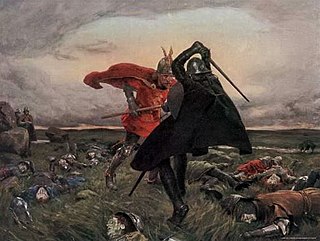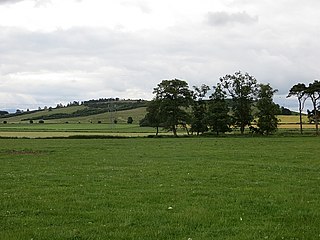
Sir Gawain and the Green Knight is a late 14th-century chivalric romance in Middle English. The author is unknown; the title was given centuries later. It is one of the best-known Arthurian stories, with its plot combining two types of folk motifs: the beheading game, and the exchange of winnings. Written in stanzas of alliterative verse, each of which ends in a rhyming bob and wheel; it draws on Welsh, Irish, and English stories, as well as the French chivalric tradition. It is an important example of a chivalric romance, which typically involves a hero who goes on a quest which tests his prowess. It remains popular in modern English renderings from J. R. R. Tolkien, Simon Armitage, and others, as well as through film and stage adaptations.

Guinevere, also often written in Modern English as Guenevere or Guenever, was, according to Arthurian legend, an early-medieval queen of Great Britain and the wife of King Arthur. First mentioned in popular literature in the early 12th century, nearly 700 years after the purported times of Arthur, Guinevere has since been portrayed as everything from a villainous and opportunistic traitor to a fatally flawed but noble and virtuous lady. Many records of the legend also feature the variably recounted story of her abduction and rescue as a major part of the tale.

Gawain, also known in many other forms and spellings, is a character in Arthurian legend, in which he is King Arthur's nephew and a Knight of the Round Table. The prototype of Gawain is mentioned under the name Gwalchmei in the earliest Welsh sources. He has subsequently appeared in many Arthurian stories in Welsh, Latin, French, English, Scottish, Dutch, German, Spanish, and Italian, notably as the protagonist of the famous Middle English poem Sir Gawain and the Green Knight. Other tales featuring Gawain as the central character include De Ortu Waluuanii, Diu Crône, Ywain and Gawain, Golagros and Gawane, Sir Gawain and the Carle of Carlisle, L'âtre périlleux, La Mule sans frein, La Vengeance Raguidel, Le Chevalier à l'épée, The Awntyrs off Arthure, The Greene Knight, and The Weddynge of Syr Gawen and Dame Ragnell.

Mordred or Modred is a figure who is variously portrayed in the legend of King Arthur. The earliest known mention of a possibly historical Medraut is in the Welsh chronicle Annales Cambriae, wherein he and Arthur are ambiguously associated with the Battle of Camlann in a brief entry for the year 537. Medraut's figure seemed to have been regarded positively in the early Welsh tradition and may have been related to that of Arthur's son.

The Battle of Camlann is the legendary final battle of King Arthur, in which Arthur either died or was fatally wounded while fighting either with or against Mordred, who also perished. The original legend of Camlann, inspired by a purportedly historical event said to have taken place in the early 6th-century Britain, appears only in vague mentions found in several medieval Welsh texts dating since around the 10th century. The battle's much more detailed depictions have emerged since the 12th century, generally based on that of a catastrophic conflict described in the pseudo-chronicle Historia Regum Britanniae. The further greatly embellished variants originate from the later French chivalric romance tradition, in which it became known as the Battle of Salisbury, and include the 15th-century telling in Le Morte d'Arthur that remains popular today.

Gaheris is a knight of the Round Table in the chivalric romance tradition of Arthurian legend. A nephew of King Arthur, Gaheris is the third son of Arthur's sister or half-sister Morgause and her husband Lot, King of Orkney and Lothian. He is the younger brother of Gawain and Agravain, the older brother of Gareth, and half-brother of Mordred. Le Morte d'Arthur depicts Gaheris as little more than a supporting character to Gawain, with an odd exception of his murder of their mother. His role is greater in the French prose cycles, including as an object of murderous sibling rivalry by Agravain in the Vulgate Cycle. Inevitably, however, he is killed alongside Gareth during Lancelot's rescue of Guinevere, the event that will lead to the fall of Arthur.
Lucius Tiberius is a Western Roman procurator or emperor from Arthurian legend, who is killed in a war against King Arthur. First appearing in Geoffrey of Monmouth's Historia Regum Britanniae, Lucius also appears in later, particularly English literature such as the Alliterative Morte Arthure and Thomas Malory's Le Morte d'Arthur. The motif of a Roman Emperor defeated by Arthur appears in the Old French literature as well, notably in the Vulgate Cycle.
This is a bibliography of works about King Arthur, his family, his friends or his enemies. This bibliography includes works that are notable or are by notable authors.
Huchoun or Huchown "of the Awle Ryale" is a poet conjectured to have been writing sometime in the 14th century. Some academics, following the Scottish antiquarian George Neilson (1858–1923), have identified him with a Scottish knight, Hugh of Eglinton, and advanced his authorship of several significant pieces of alliterative verse. Current opinion is that there is little evidence to support this.
Layamon's Brut, also known as The Chronicle of Britain, is a Middle English poem compiled and recast by the English priest Layamon. Layamon's Brut is 16,096 lines long and narrates the history of Britain. It is the first historiography written in English since the Anglo-Saxon Chronicle. Named for Britain's mythical founder, Brutus of Troy, the poem is largely based on the Anglo-Norman French Roman de Brut by Wace, which is in turn a version of Geoffrey of Monmouth's Latin Historia Regum Britanniae. Layamon's poem, however, is longer than both and includes an enlarged section on the life and exploits of King Arthur. It is written in the alliterative verse style commonly used in Middle English poetry by rhyming chroniclers, the two halves of the alliterative lines being often linked by rhyme as well as by alliteration.
The Alliterative Morte Arthure is a 4346-line Middle English alliterative poem, retelling the latter part of the legend of King Arthur. Dating from about 1400, it is preserved in a single copy in the early 15th-century Lincoln Thornton Manuscript, now in Lincoln Cathedral Library.
"The Marriage of Sir Gawain" is an English Arthurian ballad, collected as Child Ballad 31. Found in the Percy Folio, it is a fragmented account of the story of Sir Gawain and the loathly lady, which has been preserved in fuller form in the medieval poem The Wedding of Sir Gawain and Dame Ragnelle. The loathly lady episode itself dates at least back to Geoffrey Chaucer's "Wife of Bath's Tale" from The Canterbury Tales. Unlike most of the Child Ballads, but like the Arthurian "King Arthur and King Cornwall" and "The Boy and the Mantle", "The Marriage of Sir Gawain" is not a folk ballad but a song for professional minstrels.

The Wedding of Sir Gawain and Dame Ragnelle is a 15th-century English poem, one of several versions of the "loathly lady" story popular during the Middle Ages. An earlier version of the story appears as "The Wyfe of Bayths Tale" in Geoffrey Chaucer's The Canterbury Tales, and the later ballad "The Marriage of Sir Gawain" is essentially a retelling, though its relationship to the medieval poem is uncertain. The author's name is not known, but similarities to Le Morte d'Arthur have led to the suggestion that the poem may have been written by Sir Thomas Malory.
"King Arthur and King Cornwall" is an English ballad surviving in fragmentary form in the 17th-century Percy Folio manuscript. An Arthurian story, it was collected by Francis James Child as Child Ballad 30. Unlike other Child Ballads, but like the Arthurian "The Boy and the Mantle" and "The Marriage of Sir Gawain", it is not a folk ballad but a professional minstrel's song. It is notable for containing the Green Knight, a character known from the medieval poems The Greene Knight and the more famous Sir Gawain and the Green Knight; he appears as "Bredbeddle", the character's name in The Greene Knight.
The Alliterative Revival is a term adopted by literary historians to refer to the resurgence of poetry using the alliterative verse form in Middle English between c. 1350 and 1500. Alliterative verse was the traditional verse form of Old English poetry; the last known alliterative poem prior to the Revival was Layamon's Brut, which dates from around 1190.
Sir Gawain and the Carle of Carlisle is a Middle English tail-rhyme romance of 660 lines, composed in about 1400. A similar story is told in a 17th-century minstrel piece found in the Percy Folio and known as The Carle of Carlisle. These are two of a number of early English poems that feature the Arthurian hero Sir Gawain, the nephew of King Arthur, in his English role as a knight of the Round Table renowned for his valour and, particularly, for his courtesy.
The Knightly Tale of Gologras and Gawain is a Middle Scots Arthurian romance written in alliterative verse of 1362 lines, known solely from a printed edition of 1508 in the possession of the National Library of Scotland. No manuscript copy of this lively and exciting tale has survived.
The StanzaicMorte Arthur is an anonymous 14th-century Middle English poem in 3,969 lines, about the adulterous affair between Lancelot and Guinevere, and Lancelot's tragic dissension with King Arthur. The poem is usually called the Stanzaic Morte Arthur or Stanzaic Morte to distinguish it from another Middle English poem, the Alliterative Morte Arthure. It exercised enough influence on Thomas Malory's Le Morte d'Arthur to have, in the words of one recent scholar, "played a decisive though largely unacknowledged role in the way succeeding generations have read the Arthurian legend".
The Avowing of Arthur, or in full The Avowing of King Arthur, Sir Gawain, Sir Kay, and Baldwin of Britain, is an anonymous Middle English romance in 16-line tail-rhyme stanzas telling of the adventures of its four heroes in and around Carlisle and Inglewood Forest. The poem was probably composed towards the end of the 14th century or the beginning of the 15th century by a poet in the north of England. It exhibits many similarities of form and plot with Sir Gawain and the Green Knight and other romances of the Middle English Gawain cycle. Though formerly dismissed as an ill-organized collection of unconnected episodes, it has more recently been called a "complex and thought-provoking romance" with an effective diptych structure, which displays a wide knowledge of Arthurian and other tales and gives a fresh turn to them.

Tarn Wadling was a lake between Carlisle and Penrith, near the village of High Hesket in Cumbria, England. In the Middle Ages, it was famous for its carp, but it was drained in the 19th century, and is now no more than a depression. The name remains today in a small woodland governed by the Woodland Trust.










